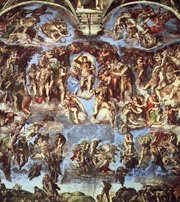Highlands Ranch High School - Mr. Sedivy
Highlands Ranch, Colorado
-
World History -
Renaissance Art
Raphael's School of Athens
Sums up the spirit of the Renaissance. Raphael pays respect to the
great thinkers and scientists of ancient Greece gathered together
at one time in a mythical school setting.
In the center are Plato and Aristotle. Plato points
up, indicating his philosophy that mathematics and pure ideas are
the source of truth, while Aristotle points down, showing his preference
for scientific of the material world. The small arch over their
heads makes a halo. There's their master, Socrates, midway to the
left, ticking off arguments on his fingers.
It was also to show that Renaissance thinkers were
as good as the ancients. The bearded figure of Plato is Leonardo.
Raphael himself is pictured, next to last, on the far right, with
the black beret. Michelangelo is the brooding, melancholy figure
in front leaning on a block of marble.

RAPHAEL: School of Athens, center view.
Click the painting for an
enlargement and complete view.
Sandro Botticelli - Birth of Venus
Venus' naked body is to be innocent, not sensual. According to myth,
Venus was born from the foam of a wave. Still only half-awake, this
fragile newborn beauty is kept afloat on a calm shell while the
winds come to blow her to shore, where the maiden waits to cover
her. It is in pastel colors to make the world itself seem fresh
and newly born.

BOTTICELLI: The Birth of Venus, 1485.
Painted for the Villa of Lorenzo di Pierfrancesco de' Medici.
Click the painting for an enlargement.
Simone Martini - Annunciation
After Giotto started, art went back to the old ways for the rest
of the 1300s. The angel appears to sternly tell. Mary, that she'll
be the mother of Jesus. In the center is a vase of lilies, a symbol
to tell us Mary is pure. Above is the Holy Spirit as a dove about
to descend on her.

SIMONE MARTINI and LIPPO MEMMI: The Annunciation.
Painted for an altar in Siena Cathedral, Florence - 1333
Michelangelo
Pieta
He didn't think of sculpting as creating a figure, but rather as
unlocking the God-made figure from the prison of marble around it.
On Christmas morning, 1972, a madman with a hammer entered St. Peter's
and began hacking away. The damage was repaired, but they had to
encase it in bulletproof glass. This is Michelangelo's only signed
work. He overheard some people praising it, but attributing it to
a second-rate sculptor form a lesser city. He was so enraged he
grabbed his chisel ad chipped his name in the ribbon running down
Mary's chest.


MICHELANGELO: Pieta; close-up of the Mary's face.
David
Michelangelo sculpted David, a symbol of divine victory over evil,
when he was 26 years old. The statue captures David as he sizes
up the enemy. David is a symbol of Renaissance optimism. He's no
brute, but a civilized, thinking individual who can grapple with
and overcome problems. The reason he is shown so big is because
it shows the power of God.

The Last Judgement. 1534-1541
Altar wall of Sistine Chapel
Click
art for an enlargement
|

David. 1501-1504
Marble, approx. 13' 5" high
Click
art for an enlargement
|
Sistine Chapel Ceiling (1508
- 1512)
The Sistine Chapel is the personal chapel of the Pope; it is also
where new popes are elected. Michelangelo turned down the project
at first; he said he was a sculptor, not a painter. It is a bunch
of frescoes. With frescoes, painting on wet plaster, if you don't
get it right the first time, you have to scrape the whole thing
off and start over. There are 600 square yards, with every inch
done by his own hand. The ceiling shows the history of the world
before the birth of Jesus.

The Creation of Adam. 1508-1512
Section of ceiling of Sistine Chapel
Last Judgement (1535)
Last Judgement was painted 23 years later. The Renaissance optimism
was fading. The Reformation had begun. Michelangelo himself was
questioning the goodness of man.
The painting is about Judgement Day. The dead at the
lower left leave their graves and prepare to be judged. The righteous,
on Christ's right hand (the left side of the picture) ascend to
the glories of Heaven. The wicked on the other side are hurled down
to Hell where demons wait to torture them. Charon, from the underworld
of Greek mythology, waits below to ferry the souls of the damned
to Hell.
No one is smiling. It's the terrifying figure of Christ
who dominates the scene. His expression is completely closed, and
He turns his head, refusing to even listen to the whining slibis
of the damned.

Mr. Sedivy at the base of the circular staircase
at the Sistine Museum.
1. What Was the Renaissance?
2. Personalities of the Italian
Renaissance
3. Renaissance Art
4. The Protestant Reformation
5. Martin Luther, Lutheranism
6. John Calvin, Calvinism
7. Anglicanism and King Henry
VIII
8. French Huguenots,
Summary of the Protestant Reformation
9. Renaissance and Reformation
Quotes
10. Most Important Invention
of the Renaissance



![]() 9375 South Cresthill Lane
9375 South Cresthill Lane ![]() Highlands Ranch, Colorado 80126
Highlands Ranch, Colorado 80126 ![]() 303-471-7000
303-471-7000








